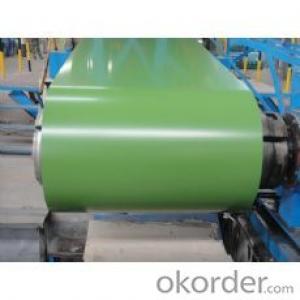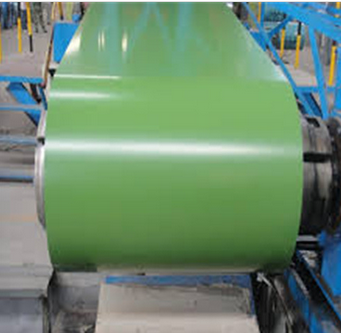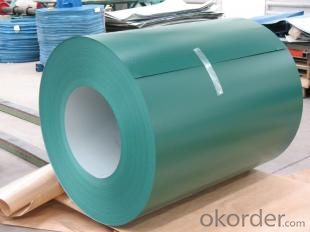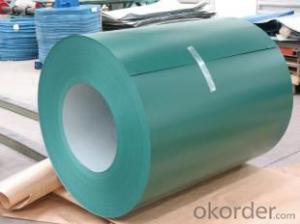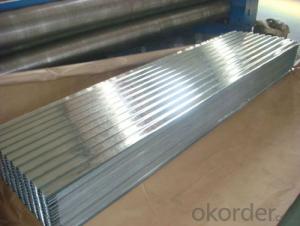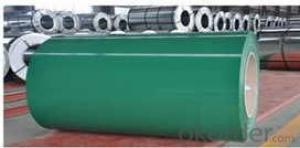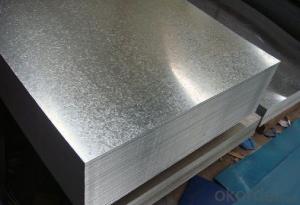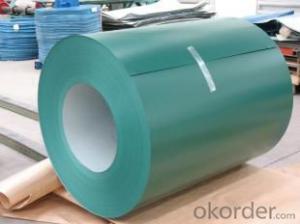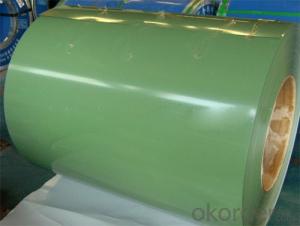Pre-Painted Galvanized Steel Coil in Best Quality Green Color
- Loading Port:
- Shanghai
- Payment Terms:
- TT OR LC
- Min Order Qty:
- 200 m.t.
- Supply Capability:
- 10000 m.t./month
OKorder Service Pledge
OKorder Financial Service
You Might Also Like
1. Pre-Painted Galvanized/Aluzinc Steel Coil Description:
With GI as base material, after pretreatment (degrease and chemical treatment ) and liquid dope with several layers of color, then after firing and cooling, finally the plate steel is called pre-painted galvanized (aluzinc) steel. Pre-painted galvanized steel is good capable of decoration, molding, corrosion resistance. It generally displays superior workability, durability and weather resistance.
2.Main Features of the Pre-Painted Galvanized/Aluzinc Steel Coil:
• Excellent process capability
• Smooth and flat surface
• Workability, durability
• Excellent heat resistance performance
• High strength
• Good formability
• Good visual effect
3.Pre-Painted Galvanized/Aluzinc Steel Coil Images
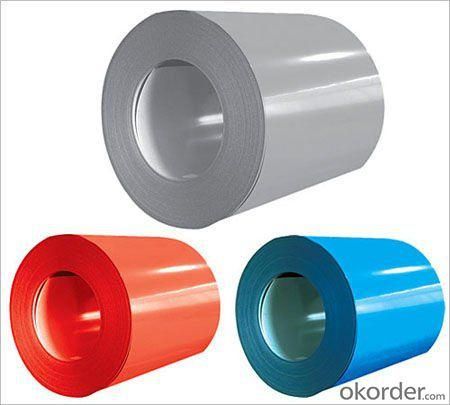
4.Pre-Painted Galvanized/Aluzinc Steel Coil Specification
Standard: AISI, ASTM, BS, DIN, GB, JIS
Grade: DX51D, DX52D
Thickness: 0.17-2.0mm
Brand Name: KMRLON
Model Number: coil
Type: Steel Coil
Technique: Cold Rolled
Surface Treatment: Coated
Application: Boiler Plate
Special Use: High-strength Steel Plate
Width: 20-1250mm
Length: customized
commoidty: pre-painted galvanized steel coil
Thickness: 0.13-4.0mm
width: 20-1250mm
zinc coating: 40-180g/m2
printing thickness: top side: 20+/-5 microns, back side: 5-7 microns
color: all RAL color
surface treatment: color coated
coil weight: 4-7 tons
coil ID: 508/610mm
packaging: standard seaworthy packing
5.FAQ of Pre-Painted Galvanized/Aluzinc Steel Coil
1. What’s the application of this product?
Roof, roof structure, surface sheet of balcony, frame of window, etc.
2. What’s the brand of the paint?
We use the best brand of all of the word—AKZO.
3. How to guarantee the quality of the products?
We have established the international advanced quality management system,every link from raw material to final product we have strict quality test;We resolutely put an end to unqualified products flowing into the market. At the same time, we will provide necessary follow-up service assurance.
4. How long can we receive the product after purchase?
Usually within thirty working days after receiving buyer’s advance payment or LC. We will arrange the factory manufacturing as soon as possible. The cargo readiness usually takes 15-25 days, but the shipment will depend on the vessel situation.
- Q: I bought this Brinks pad lock and it says boron steel on the lock. I was just wondering what exactly is boron steel and how hard/tough is it?
- Boron steel is rather hard, it is by no means titanium, but certainly better than mild steel. However, as with all metals, hardness is inversely proportional to flexibility, meaning that a good solid whack with a sledge hammer could crack your lock.
- Q: What is the shear modulus of steel and silver? Please help! and state where you got it from...what site did you used? Thanks.
- Modulus Of Rigidity Of Steel
- Q: What are the common challenges faced in steel coil production?
- Some common challenges faced in steel coil production include ensuring consistent quality and dimensional accuracy, managing the high energy consumption involved in the production process, handling and transporting heavy coils safely, and minimizing the risk of surface defects and damage during processing and storage. Additionally, maintaining efficient production speeds, optimizing material utilization, and meeting customer demands for timely delivery can also pose challenges in steel coil production.
- Q: I expect that I will be questioned about my knowledge in methoding for steel castings, in a interview. I dont know about it. Can someone explain me in simple language and give me some links, like how I can explain methoding for steel castings.....key points...help please...so that i will pass the interview as if I have experience in methoding....thanks
- It is very difficult to define Methoding of Steel castings by one sentence. Actually it encompasses the total casting process. Normally it would mean a) Pattern design i.e. what type of pattern it would be- wooden, metallic, split or full, loose or fitted on a match plate or any other, how will be the parting line. b) Design of the gating system. c) Design of risering i.e. numbers, size and location of risers. d) Design of molding process i.e. sand system to be used, mold box size. But to do justice to the above mentioned activities, you need to consider other parameters of the casting process such as chemical composition, solidification characteristics, pouring temperature, pouring time, knock out time etc. As I said Methoding of Steel castings means designing of the total casting process from inception to final product.
- Q: Can steel and/or stainless steel turn rusty ?
- from wikipedia: In metallurgy, stainless steel, also known as inox steel or inox from French inoxydable, is defined as a steel alloy with a minimum of 10.5% to 11% chromium content by mass. Stainless steel does not corrode, rust or stain with water as ordinary steel does, but despite the name it is not fully stain-proof, most notably under low oxygen, high salinity, or poor circulation environments. It is also called corrosion-resistant steel or CRES when the alloy type and grade are not detailed, particularly in the aviation industry. There are different grades and surface finishes of stainless steel to suit the environment the alloy must endure. Stainless steel is used where both the properties of steel and resistance to corrosion are required. Stainless steel differs from carbon steel by the amount of chromium present. Unprotected carbon steel rusts readily when exposed to air and moisture. This iron oxide film (the rust) is active and accelerates corrosion by forming more iron oxide, and due to the dissimilar size of the iron and iron oxide molecules (iron oxide is larger) these tend to flake and fall away. Stainless steels contain sufficient chromium to form a passive film of chromium oxide, which prevents further surface corrosion and blocks corrosion from spreading into the metal's internal structure, and due to the similar size of the steel and oxide molecules they bond very strongly and remain attached to the surface.
- Q: What are the common coil thickness tolerances?
- The common coil thickness tolerances vary depending on the specific industry and application. However, generally speaking, the typical coil thickness tolerances range from ±0.001 to ±0.005 inches (or ±0.025 to ±0.127 millimeters). These tolerances ensure that the coil meets the required specifications and can perform its intended function accurately.
- Q: Are steel coils corrosion-resistant?
- Yes, steel coils can be made corrosion-resistant through various methods such as galvanization or coating them with protective layers.
- Q: How do steel coils compare to stainless steel coils?
- Steel coils and stainless steel coils are both used in various industries, but they differ in their composition and properties. Steel coils are typically made from carbon steel, which is strong and durable but susceptible to corrosion. On the other hand, stainless steel coils are made from an alloy of iron, chromium, and other elements, which provides them with excellent corrosion resistance. Stainless steel coils also have a higher resistance to heat and oxidation, making them suitable for applications that require superior durability and hygiene standards. Overall, stainless steel coils are generally considered to be of higher quality and more suitable for applications where corrosion resistance is crucial.
- Q: What are the different methods of coil packaging for steel coils?
- There are several different methods of coil packaging for steel coils, each with its own advantages and suitability for specific applications. Some of the common methods include: 1. Strapping: This method involves using steel or plastic strapping to secure the coil and prevent it from unwinding or shifting during transportation. Strapping can be done manually or with the help of strapping machines, offering a cost-effective and reliable packaging solution. 2. Stretch wrapping: Stretch wrapping involves using a stretch film to tightly wrap the coil. The film is stretched and wrapped around the coil, providing protection against dust, moisture, and damage. This method is suitable for lightweight coils and offers good visibility of the product. 3. Steel banding: Steel banding is a robust and heavy-duty packaging method that involves using steel bands to secure the coil. This method provides high strength and durability, ensuring that the coil remains intact during transportation or storage. 4. Edge protectors: Edge protectors are used in conjunction with other packaging methods to safeguard the edges of the coil. These protectors are typically made of cardboard or plastic and provide additional support to prevent edge damage. 5. Wooden crates: For heavy or fragile steel coils, wooden crates are often used to provide maximum protection. The coils are placed inside the crate and secured with strapping or steel banding. Wooden crates offer excellent strength and stability and can be customized to fit specific coil dimensions. 6. Paper interleaving: This method involves inserting layers of paper or cardboard between individual wraps of the coil to prevent scratching or marking. Paper interleaving is commonly used when the coils are stacked together or when they have a high surface finish that needs to be protected. 7. Automated packaging systems: In larger-scale operations, automated packaging systems can be utilized. These systems are designed to handle and package coils using various methods, such as strapping, stretch wrapping, or steel banding. They offer increased efficiency and productivity while ensuring consistent and secure packaging. The choice of coil packaging method depends on factors such as the size and weight of the coil, transportation requirements, level of protection needed, and cost considerations. It is essential to select the appropriate packaging method to ensure the safe delivery of steel coils to their destination.
- Q: Are steel coils used in automotive manufacturing?
- Yes, steel coils are commonly used in automotive manufacturing. They are used to produce various components such as body panels, chassis parts, and suspension components. The high tensile strength and durability of steel make it an ideal material for creating safe and robust automobiles.
Send your message to us
Pre-Painted Galvanized Steel Coil in Best Quality Green Color
- Loading Port:
- Shanghai
- Payment Terms:
- TT OR LC
- Min Order Qty:
- 200 m.t.
- Supply Capability:
- 10000 m.t./month
OKorder Service Pledge
OKorder Financial Service
Similar products
Hot products
Hot Searches
Related keywords
